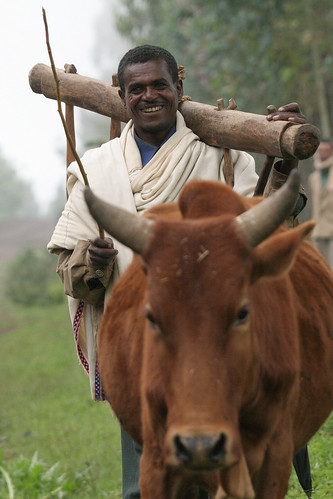Samuel Adugna carries his wooden plough out to his fields for a day’s work with his two oxen near Wenchi town, in the Ethiopian highlands (photo credit: ILRI/Mann).
State of the World, the flagship annual publication from the Worldwatch Institute (Nourishing the Planet), this year focuses on 15 agricultural innovations that can nourish both people and their environments. Sustainable livestock production in developing countries is included as one such solution.
‘For over 40 years, Earth Day has served as a call to action, mobilizing individuals and organizations around the world to address these challenges. This year Nourishing the Planet highlights agriculture—often blamed as a driver of environmental problems—as an emerging solution.
‘Agriculture is a source of food and income for the world’s poor and a primary engine for economic growth. It also offers untapped potential for mitigating climate change and protecting biodiversity, and for lifting millions of people out of poverty.
‘This Earth Day, Nourishing the Planet offers 15 solutions to guide farmers, scientists, politicians, agribusinesses and aid agencies as they commit to promoting a healthier environment and a more food-secure future.’
One of the 15 solutions highlighted in the State of the World 2011 is improving food production from livestock. This chapter, written by Mario Herrero and other staff of the International Livestock Research Institute (ILRI), describes how:
‘. . . In the coming decades, small livestock farmers in the developing world will face unprecedented challenges: demand for animal-source foods, such as milk and meat, is increasing, while animal diseases in tropical countries will continue to rise, hindering trade and putting people at risk. Innovations in livestock feed, disease control, and climate change adaptation–as well as improved yields and efficiency–are improving farmers’ incomes and making animal-source food production more sustainable. In India, farmers are improving the quality of their feed by using grass, sorghum, stover, and brans to produce more milk from fewer animals. . . .’
Read the whole article, which is cross-posted on the websites of the Huffington Post and Worldwatch Institute’s Nourishing the Planet: Agriculture: The unlikely Earth Day hero, 19 April 2011.
Read the whole livestock chapter in the State of the World.
Purchase the book, State of the World 2011: Innovations that Nourish the Planet, in which this and 14 other solutions are described and watch a one-minute book trailer.


